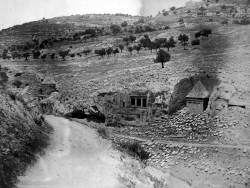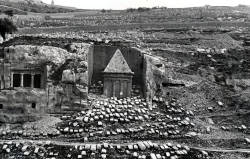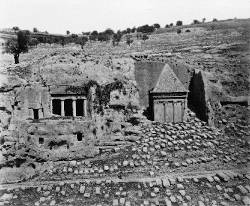Tomb of Zechariah
Useful Information


| Location: |
Kidron Valley, Jerusalem.
(31.776623, 35.238966) |
| Open: |
no restrictions. [2021] |
| Fee: |
free. [2021] |
| Classification: |
 Höhlengrab Höhlengrab
|
| Light: | n/a |
| Dimension: | |
| Guided tours: | self guided |
| Photography: | allowed |
| Accessibility: | no |
| Bibliography: | |
| Address: | Tomb of Zechariah, Tel: +972-2-627-5050. |
| As far as we know this information was accurate when it was published (see years in brackets), but may have changed since then. Please check rates and details directly with the companies in question if you need more recent info. |
|
History
| 1st century | tomb built. |
| 1215 | first mentioned as Tomb of Zechariah by Menachem haHebroni. |
Description



The Tomb of Zechariah or Pyramid of Zechariah is a rock cut tomb. It is not just an artificial cave like other tombs, it is a sculpture cut out of the massive rock, a so-called monolithic building. It is located in the Kidron valley, known in the Bible as the Valley of Jehoshaphat, east of Jerusalem city center, between the city and the Mount of Olives. It is one of four graves at this location. Traditionally it was ascribed to Zechariah, however, such relations are often a result of the interpretation of bible passages and not archaeological evidence.
Zechariah ben Jehoiada, son of Jehoiada the priest, who lived probably in the 9th century BC, during the period of the first temple. He was a priest and a prophet who delivered God’s message, according to the Bible he was stoned to death in the temple, by the orders of King Yoash (King of Judah, son of Ahaziah). During the reign of King Nebuchadnezzar II, Zechariah condemned the people for their rebellion against God. The tradition to call this building the Tomb of Zechariah originates from the Middle Ages, it was written by Menachem haHebroni in 1215. Since then, it was a site of Jewish prayers, especially on the 9th of the month of Av, the day of the destruction of the temple. Quite funny is the fact that prayers for rain on dry winters succeeded in 1651 and 1690 and stopped the drought. Pretty good score, two cases in hundreds of years...
There is another prophet Zechariah, son of Berechiah, who lived 300 years later during the second temple period, 6th century BC.
He is said to be the author of the book of Zechariah, at least the first part.
According to tradition, he is buried on Mount of Olives, in the
 Tomb of the Prophets
on top of the hill.
Tomb of the Prophets
on top of the hill.
This building is smaller than nearby Tomb of Absalom, but still not less spectacular. The main part is a square pilar or cube, with fake round columns with Ionic capitals, which were chiseled into the massive limestone. It has a sort of capital or fries on top and then a square pyramid as roof. The sides and the rear wall of the tomb are extremely rough and unfinished, it seems the work was stopped before the artists were finished. At the foot is a crepidoma, a base with three steps. The construction, which includes Hellenistic details such as Ionic columns, is nowadays dated to the first century. Some think it is actually not a tomb, but the nefesh, a Jewish funerary monument similar to the Greek stele, for the adjacent Tomb of Benei Hezir.
The whole monument was surrounded by a huge number of stone tombstones, which covered individual graves. The Mount of Olive was controlled by the Jordanians between 1948 and 1967 who demolished tombstones and used them as building material. They also built a Jordanian military camp, a road, and a hotel at the top of the Mount of Olives, destroying numerous graves. Obviously not a respectful behaviour and despised by the Jews, who regained control of this area during the Six Day War. But the removal of the graves around the Tomb of Absalom revealed an opening in the center of the front stairs, which leads to an inner chamber. As far as we understand this chamber is empty and open, the tomb does not contain a body, so you can have a look. We recommend bringing a torch.
- See also
 Search DuckDuckGo for "Tomb of Zechariah"
Search DuckDuckGo for "Tomb of Zechariah" Google Earth Placemark
Google Earth Placemark Tomb of Zechariah - Wikipedia (visited: 16-DEC-2021)
Tomb of Zechariah - Wikipedia (visited: 16-DEC-2021) Tomb of Zechariah (visited: 16-DEC-2021)
Tomb of Zechariah (visited: 16-DEC-2021) Tomb of Zechariah (visited: 16-DEC-2021)
Tomb of Zechariah (visited: 16-DEC-2021) The Tomb of Zechariah facing the old city of Jerusalem is considered to be a great symbol of the Holy City (visited: 16-DEC-2021)
The Tomb of Zechariah facing the old city of Jerusalem is considered to be a great symbol of the Holy City (visited: 16-DEC-2021)
 Index
Index Topics
Topics Hierarchical
Hierarchical Countries
Countries Maps
Maps